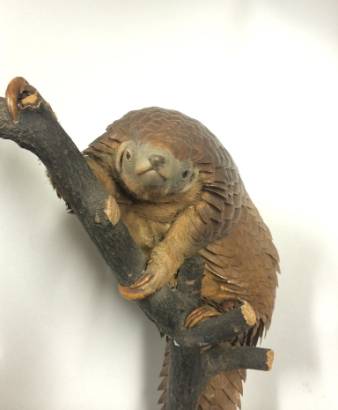What does the future hold for the Pangolin? They are rapidly earning the reputation of being the mammal with the world’s highest level of illegal trade, yet many people have never heard of them.
Louise Tomsett, Mammal Curator at the NHM, is giving two Nature Live events on Saturday 21st February 2015 - World Pangolin Day - in order to raise awareness of these lesser-known animals, and to highlight the threat of extinction due to the illegal wildlife trade. She will be showing specimens from the NHM’s scientific collections, not normally on display to the public.
What are pangolins?
Pangolins are nicknamed "scaly anteaters" but they are not the same animal we generally think of as an anteater. Despite their distinctive appearance, making them hard to confuse with any other mammal, relatively few people know about them. The scales cover most of their body, giving them the appearance of a "living pine cone" or artichoke. They live in a variety of habitats such as grassland, rainforest and agricultural areas such as plantations. There are four species in Africa and four in Asia.
Pangolins are well adapted to their ecological niche. They feed primarily on ants and termites, using large, powerful claws to break open nests and mounds, and very long, sticky tongues to lick up the insects. Their specialised ears and eyelids can be closed to prevent attack by ants. The scales are an aid for digging burrows, and help some species climb trees in addition to acting as armour against ants and larger attackers such as lions.
When threatened pangolins curl up into a tight ball, rendering them virtually impenetrable, even to a lion’s teeth. Their common name ‘pangolin’ even comes from a Malay term generally meaning ‘rolled up’. Unfortunately it is this defence mechanism that also makes them rather easy for poachers to pick up and carry.
Conservation issues
The main threats to pangolins are the illegal wildlife trade and habitat destruction. Trade in pangolins (live and dead) is on an international scale, with confiscated shipments often amounting to tonnes. Quantities found in seized shipments represent only a fraction of the real numbers traded and estimates of the trade indicate as much as tens of thousands of individuals each year. The main drive for trade is the falsely attributed health benefits of pangolin meat and other body parts such as scales. Alleged benefits range from curing acne to curing cancer. In some countries, the sheer cost of the meat and being able to afford it is used as a status symbol. Pangolins are also used as bush meat, for indigenous folk-law rituals and for leather goods.
The traditional source for pangolins for the illegal trade is southeast Asia but this is now appearing to change, with African pangolins now a target as Asian pangolins run out. The consequence is that all species of pangolins are now threated with extinction.
Tree or African White-Bellied Pangolin
Pangolins are easily stressed and many die during the hunting and trafficking process, or even once rescued. They are extremely difficult to keep in captivity due to the fact that very little is known about their biology and care. In addition to this a continuous food supply of live ants and termites is very difficult to source. They have rarely been bred successfully and usually only have one offspring at a time so with current hunting levels, populations are not sustainable.
Scale of the Giant African Pangolin
The NHM’s collections are used by scientific researchers from all over the world. Like many of our collections, the pangolin specimens we hold contain a wealth of information, much of it waiting to be unlocked. For example, the geographical information can provide historical species ranges, specimen tissue samples for DNA analysis shows the genetics of different populations and isotope analysis of samples indicates geographical sources and movements during an individual’s life. All of this information is extremely valuable for conservation.
Louise Tomsett
#worldpangolinday



